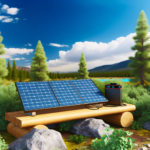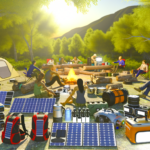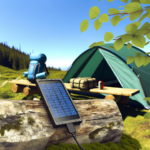Introduction to Solar Energy
What is Solar Energy?
Solar energy is the radiant light and heat from the sun that is harnessed using a range of technologies such as solar panels, solar thermal collectors, and solar architecture. This renewable energy source is abundant, sustainable, and environmentally friendly, making it a key player in the transition to cleaner energy systems. Solar energy can be converted into electricity or used directly for heating purposes, providing a versatile solution for various energy needs.
The Importance of Solar Energy for Eco-Adventurers
For eco-adventurers, solar energy is a game-changer. It offers a reliable and sustainable power source that aligns with the principles of environmental stewardship and self-sufficiency. Whether you’re camping in remote locations, embarking on a cross-country road trip, or living off-grid, solar energy provides the freedom to explore without the constraints of traditional power sources. By reducing reliance on fossil fuels and minimizing carbon footprints, eco-adventurers can enjoy their journeys while contributing to the preservation of natural landscapes.
How Solar Energy Works
Understanding how solar energy works is crucial for maximizing its benefits. The process begins with solar panels, which are composed of photovoltaic (PV) cells. These cells are made from semiconductor materials, typically silicon, that absorb sunlight and generate an electric current. Here’s a step-by-step breakdown of the process:
1. **Absorption of Sunlight**: When sunlight hits the PV cells, it excites electrons in the semiconductor material, creating an electric field.
2. **Generation of Direct Current (DC)**: The movement of these excited electrons generates direct current (DC) electricity.
3. **Conversion to Alternating Current (AC)**: Since most household appliances and electronic devices run on alternating current (AC), an inverter is used to convert the DC electricity into AC.
4. **Energy Storage**: Excess energy can be stored in batteries for later use, ensuring a continuous power supply even when the sun isn’t shining.
5. **Usage**: The generated electricity can be used to power various devices, from small gadgets to larger appliances, providing a versatile and reliable energy source.
By harnessing the power of the sun, eco-adventurers can enjoy a sustainable and independent energy solution that enhances their outdoor experiences.
Benefits of Solar Energy for Outdoor Enthusiasts
Environmental Benefits
For eco-adventurers, the environmental benefits of solar energy are paramount. Solar power is a clean, renewable energy source that significantly reduces carbon footprints. Unlike fossil fuels, solar energy does not produce harmful emissions or pollutants, making it an ideal choice for those who cherish the natural world. By harnessing the sun’s power, outdoor enthusiasts can minimize their impact on the environment, preserving the beauty and health of the ecosystems they explore.
Economic Advantages
Solar energy also offers substantial economic benefits. While the initial investment in solar panels or solar-powered gadgets can be significant, the long-term savings are considerable. Solar energy systems reduce or even eliminate the need for traditional fuel sources, such as gasoline for generators. This translates to lower operational costs over time. Additionally, many regions offer incentives, rebates, or tax credits for solar energy installations, further offsetting the initial costs. For those who spend extended periods off-grid, the economic advantages of solar energy can be particularly compelling.
Convenience and Independence
One of the most appealing aspects of solar energy for outdoor enthusiasts is the convenience and independence it provides. Solar panels and solar-powered devices allow adventurers to generate electricity anywhere the sun shines, eliminating the need for noisy, fuel-dependent generators. This independence is especially valuable in remote locations where access to traditional power sources is limited or non-existent. Solar energy systems are typically low-maintenance and reliable, ensuring a steady power supply for essential devices like GPS units, communication tools, and lighting. This convenience enhances the overall outdoor experience, allowing adventurers to focus on their activities without worrying about power availability.
Types of Solar Power Solutions
Portable Solar Panels
Portable solar panels are a game-changer for eco-adventurers who need a reliable and renewable energy source while on the go. These panels are designed to be lightweight, foldable, and easy to transport, making them ideal for camping, hiking, and other outdoor activities. They can be set up quickly to capture sunlight and convert it into electricity, which can then be used to charge devices like smartphones, cameras, and portable power stations. **EcoFlow’s range of portable solar panels** offers a variety of options to suit different needs, from small, compact panels to larger, more powerful ones.
Solar Generators
Solar generators are an excellent solution for those who need more substantial power on their adventures. These devices combine solar panels with a battery storage system, allowing you to store energy for use when the sun isn’t shining. **EcoFlow’s DELTA series** is a prime example, offering robust storage capacities and the ability to charge via both solar and electric sources. These generators are perfect for powering larger appliances, such as portable refrigerators, lights, and even small air conditioners, providing a level of comfort and convenience that traditional gas generators can’t match.
Solar-Powered Gadgets
For those who prefer to travel light, solar-powered gadgets offer a convenient way to keep essential devices running. These gadgets include solar-powered chargers, lanterns, and even cookers. They are designed to be compact and efficient, harnessing the sun’s energy to power your devices directly. **EcoFlow’s WAVE 2**, a wireless portable air conditioner and heater, is an innovative example that provides both cooling and heating capabilities without the need for installation, making it perfect for both indoor and outdoor use.
Solar Water Heaters
Solar water heaters are an excellent addition for those who enjoy extended stays in the great outdoors. These systems use solar energy to heat water, providing a sustainable and eco-friendly way to enjoy hot showers and warm water for cooking and cleaning. They are particularly useful in remote locations where traditional water heating methods are impractical. Solar water heaters come in various sizes and capacities, making it easy to find one that fits your specific needs and space constraints.
In summary, the variety of solar power solutions available today makes it easier than ever for eco-adventurers to enjoy their outdoor experiences without compromising on comfort or convenience. Whether you need a portable solar panel for a weekend hike, a solar generator for a longer trip, or solar-powered gadgets to keep your essentials running, there’s a solution out there to meet your needs.
Choosing the Right Solar Solution
Assessing Your Energy Needs
Before diving into the world of solar solutions, it’s crucial to understand your energy requirements. Start by listing all the devices you plan to power during your adventures. Note the wattage and the hours each device will run daily. Multiply the wattage by the hours to find the daily watt-hours (Wh) for each device. Add all the daily watt-hours to get the total energy consumption. For example, if you have a light that uses 10 watts for 4 hours, a TV that uses 100 watts for 1 hour, and a fridge that uses 50 watts for 24 hours, your total daily energy consumption would be 1340Wh. This calculation helps you determine the size and type of solar solution you need.
Evaluating Portability and Durability
For eco-adventurers, portability and durability are key factors in choosing the right solar solution. Portable solar panels are lightweight and easy to move, making them perfect for camping, road trips, and outdoor activities. Folding solar panels, which fold up like a briefcase, offer even more compactness and ease of transport. Durability is equally important; look for panels that can withstand harsh weather conditions and rough handling. Products like the EcoFlow Alternator Charger, which harnesses vehicle alternator energy, provide a robust and portable solution for on-the-road power needs.
Understanding Efficiency Ratings
Efficiency ratings are a critical aspect of solar solutions. The efficiency of a solar panel indicates how well it converts sunlight into usable electricity. Higher efficiency panels generate more power in a smaller footprint, which is particularly beneficial for limited space scenarios like RVs or camping setups. Additionally, consider the type of solar regulator you use. MPPT (Maximum Power Point Tracking) regulators are more efficient than PWM (Pulse Width Modulation) regulators, converting excess voltage into extra current and operating at about 97% efficiency. This ensures you get the most out of your solar panels.
Budget Considerations
Budget is always a significant factor when choosing a solar solution. While high-efficiency panels and advanced regulators like MPPT are more expensive, they offer better performance and long-term savings. It’s essential to balance your initial investment with the benefits you expect to gain. For instance, EcoFlow’s range of products, including the DELTA series portable power stations, offers various options at different price points. Bundles like the Alternator Charger with DELTA 2 Max provide cost-effective solutions with significant discounts, making advanced solar technology more accessible.
By carefully assessing your energy needs, evaluating portability and durability, understanding efficiency ratings, and considering your budget, you can choose the right solar solution that enhances your eco-adventures while promoting sustainability.
Installation and Maintenance Tips
Setting Up Your Solar Panels
Setting up your solar panels correctly is crucial for maximizing their efficiency and ensuring they provide a reliable power source during your adventures. Here are the steps to follow:
1. **Choose the Right Location**: Select a spot with maximum sunlight exposure. Avoid areas with shade from trees, buildings, or other obstructions.
2. **Mounting the Panels**: Depending on the type of solar panel (fixed, portable, or folding), mount them securely. Fixed panels should be installed on a stable surface like the roof of a vehicle or a structure. Portable and folding panels can be placed on the ground or any flat surface.
3. **Angle and Orientation**: Adjust the angle of the panels to capture the most sunlight. In the northern hemisphere, panels should generally face south, while in the southern hemisphere, they should face north. The optimal angle is usually equal to the latitude of your location.
4. **Connecting to the System**: Use appropriate connectors (e.g., MC4 plugs) to link the solar panels to your charge controller and battery. Ensure all connections are secure and weatherproof.
Maintaining Your Solar Equipment
Proper maintenance of your solar equipment ensures longevity and consistent performance. Here are some tips:
1. **Regular Cleaning**: Dust, dirt, and debris can accumulate on the surface of the panels, reducing their efficiency. Clean the panels with a soft cloth and mild detergent regularly.
2. **Inspect Connections**: Periodically check all electrical connections for signs of wear, corrosion, or damage. Tighten any loose connections and replace damaged components.
3. **Monitor Performance**: Use a solar charge controller with a display to monitor the performance of your system. Keep an eye on the voltage and current to ensure everything is functioning correctly.
4. **Battery Maintenance**: If you are using lead-acid batteries, check the electrolyte levels and top up with distilled water if necessary. For lithium batteries, ensure they are not exposed to extreme temperatures.
Troubleshooting Common Issues
Even with proper setup and maintenance, you may encounter some common issues with your solar power system. Here’s how to troubleshoot them:
1. **Low Power Output**:
– **Check for Obstructions**: Ensure there are no shadows or obstructions blocking the sunlight.
– **Clean the Panels**: Dirty panels can significantly reduce power output. Clean them as needed.
– **Inspect Connections**: Loose or corroded connections can cause power loss. Tighten and clean all connections.
2. **Battery Not Charging**:
– **Check the Charge Controller**: Ensure the charge controller is functioning correctly and set up properly.
– **Inspect the Battery**: Test the battery voltage. If it’s too low, it might need to be replaced.
– **Verify Panel Output**: Use a multimeter to check the voltage output from the panels. If it’s too low, the panels might be damaged or not receiving enough sunlight.
3. **System Overheating**:
– **Ensure Proper Ventilation**: Make sure there is adequate airflow around the panels and other components.
– **Check for Overloading**: Ensure you are not drawing more power than the system is designed to handle.
By following these installation and maintenance tips, you can ensure your solar power system remains efficient and reliable, providing you with the energy you need for your eco-adventures.
Maximizing Solar Energy Use
Optimal Placement and Angling
To maximize the efficiency of your solar energy system, proper placement and angling of solar panels are crucial. **Solar panels should ideally be placed in an area that receives maximum sunlight throughout the day.** This typically means avoiding shaded areas caused by trees, buildings, or other obstructions.
The angle at which the panels are installed also plays a significant role. The optimal angle depends on your geographical location. For instance, in the Northern Hemisphere, solar panels should generally be tilted at an angle equal to your latitude. This ensures that the panels capture the maximum amount of sunlight year-round. Adjustable mounts can be particularly useful, allowing you to change the angle seasonally to optimize solar gain.
Energy Storage Solutions
One of the challenges of relying on solar energy is its intermittent nature. **Energy storage solutions, such as solar batteries, are essential for ensuring a consistent power supply.** These batteries store excess energy generated during sunny periods, which can then be used during cloudy days or at night.
There are various types of solar batteries available, including lithium-ion, lead-acid, and flow batteries. **Lithium-ion batteries are popular due to their high efficiency and long lifespan.** When choosing a battery, consider factors such as capacity, depth of discharge, and cycle life. Properly sizing your battery storage to match your energy needs will ensure you have a reliable power source when you need it most.
Seasonal Considerations
Seasonal changes can significantly impact the performance of your solar energy system. **During winter months, shorter days and lower sun angles can reduce the amount of solar energy captured.** To mitigate this, you may need to adjust the tilt angle of your panels to capture more sunlight. Additionally, keeping panels free of snow and debris is essential for maintaining efficiency.
In contrast, summer months typically offer longer days and more direct sunlight, increasing energy production. However, high temperatures can reduce the efficiency of solar panels. **Ensuring proper ventilation and cooling can help maintain optimal performance.**
By understanding and adapting to these seasonal variations, you can maximize the efficiency and reliability of your solar energy system year-round.
Future Trends in Solar Technology
Innovations in Solar Panels
The solar panel industry is experiencing rapid advancements, making solar energy more efficient and accessible than ever before. One of the most exciting developments is the creation of *bifacial solar panels*, which can capture sunlight from both sides, significantly increasing energy output. Additionally, *perovskite solar cells* are emerging as a game-changer due to their high efficiency and lower production costs compared to traditional silicon-based cells. These innovations are not only enhancing the performance of solar panels but also making them more affordable for the average consumer.
Advancements in Solar Batteries
Energy storage is a critical component of any solar power system, and recent advancements in solar batteries are making it easier for eco-adventurers to store and use solar energy efficiently. The development of *solid-state batteries* promises higher energy densities and longer lifespans compared to conventional lithium-ion batteries. Moreover, companies like EcoFlow are introducing versatile solutions such as the *Alternator Charger*, which can harness excess vehicle alternator energy to recharge portable power stations quickly. This innovation ensures that outdoor enthusiasts have a reliable and fast-charging energy source, even when they are on the move.
Emerging Solar Applications
The applications of solar technology are expanding beyond traditional uses, offering new ways for eco-adventurers to harness the power of the sun. *Solar-powered gadgets* like portable air conditioners, heaters, and even cooking devices are becoming increasingly popular. For instance, EcoFlow’s WAVE 2 is a wireless portable air conditioner and heater that provides efficient climate control for both indoor and outdoor spaces without the need for installation. Additionally, *solar water heaters* are gaining traction, providing a sustainable way to heat water for showers and cooking while off the grid. These emerging applications are making it easier for outdoor enthusiasts to enjoy modern conveniences without relying on non-renewable energy sources.
In summary, the future of solar technology is bright, with continuous innovations in solar panels, advancements in energy storage solutions, and the development of new solar-powered applications. These trends are making solar energy more efficient, accessible, and versatile, ensuring that eco-adventurers can enjoy their outdoor experiences with minimal environmental impact.






